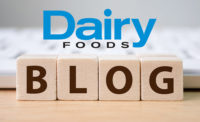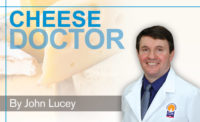
Minimal Impact
by Shonda Talerico Dudlicek
Less is more when it comes to environmentally friendly
packaging.
Stop — put down that
dairy product. Take a look at its packaging. Is it environmentally sound,
socially responsible and economically viable? Is it easily recyclable?
Will it lounge around for years in a landfill? Or is
it environmentally sustainable?
Environmentally conscious consumers are seeking out
products with easily recyclable packaging. Dairy processors can help meet
this demand by offering environmentally friendly packaging, or by using
less packaging and more earth-friendly materials.
“Of course, consumers want packaging that has
minimal impact on the environment,” says Ed Klein, vice president of
environmental affairs, Tetra Pak, Vernon Hills, Ill. “Today, that
often means packaging that can be recycled. Consumers are becoming
increasingly aware of the environmental and societal benefits of packaging
that is made from renewable domestic resources. Consumers also want to buy
products from good corporate citizens.”
In the dairy industry, Tetra Pak is among the
nation’s largest providers of gabletop cartons for milk beverages.
“Tetra Pak also provides dairies and brand owners with the ability to
provide aseptic milk, which is essentially the same as pasteurized milk,
but is shel stable thanks to ultra-high temperature processing and a
patented six-layer package which protects the taste and nutritional value
of the product,” Klein explains.
The most important environmental trend in packaging,
Klein says, is sustainability, which he describes as “packaging
that allows society to thrive today without compromising that ability of
future generations to thrive, as well.” In essence, sustainable
packaging is packaging that is environmentally sound, socially responsible
and economically viable. Fully sustainable packaging should optimize
materials and energy, meet market needs for performance and cost, be safe
throughout its life cycle and, once used, provide a valuable resource.
No packaging is fully sustainable, but sustainability
provides a useful framework to increase benefits, while reducing
environmental costs to society, Klein says, pointing to Wal-Mart’s
recent decision to commit to “environmental sustainability,”
focusing on is packaging that is more sustainable.
“Tetra Pak’s aseptic and gabletop cartons
are well along the road to sustainability,” Klein says. Aseptic dairy
products, which are common throughout the world, are gaining awareness and
acceptance in the United States. Their packaging is made primarily from
paper, a renewable and renewed domestic resource.
“The paper in our packages comes from
well-managed tree farms, where our suppliers plant more trees than they cut
down and preserve biodiversity,” Klein says. “Our cartons allow
for the safe delivery of nutritious beverages, such as milk, to consumers.
Aseptic cartons do so without the need for refrigeration or preservatives.
“Tetra Pak is the industry leader in
facilitating recycling and composting of beverage cartons in the
U.S.,” Klein says. “Approximately 43 million people can recycle
beverage cartons. The fiber from cartons is recovered to make valuable
products, such as tissue and paper towels. And, gabletop cartons are part
of the growing number of food compost programs in the U.S.”
The company is also reducing its energy footprint,
reducing its per-package consumption of energy at its plants by 15 percent
since 2002 and is committed to reducing its reliance on fossil fuel at our
plants by another 10 percent by 2008. “We also have planted 28,000
trees with American forests to offset our air travel and reduce our impact
on climate change,” Klein says.
According to Klein, most dairy processors regard the
environment in the context of meeting market needs for performance and
cost. “Over time, assuming sustainable packaging becomes more
prominent, dairy processors — like others who put their products in
packaging — will adapt to the changing requirements of consumers and retailers,” he says.
Reduce, Reuse
More and more environmentally conscious consumers are
looking for packaging that is easy to recycle, but this alone is not a
deciding factor in deciding to buy, says Stephane Auclair, dairy category
manager in the food packaging division at IPL Packaging Inc., Saint-Damien,
Quebec, Canada.
“When a consumer purchases a food product
because he intends to reuse the package, whether it’s because of
environmental consciousness or for practical reasons, like storing screws,
the environment cause has been served,” Auclair says.
“Considering that most consumers are still not making their purchase
decision based on the ‘recyclability’ of the packaged good,
dairy processors still mainly focus on package price, and then also on how
well the package performs at merchandising their products.”
IPL Packaging, a producer of molded plastic
containers, features tamper-evident, space-saving and easy-to-use
containers and in-mold labeling (IML). The labels are environmentally
friendly because they are made of polypropylene, the same resin as the
containers. This makes the packaging 100 percent recyclable, as opposed to
containers affixed with a pressure-sensitive or glued-on label, Auclair
says.
With IML, a printed polypropylene label is placed in
an open mold and held in the desired position by vacuum ports,
electrostatic attraction and other means. The mold closes and molten
plastic resin is injected into the mold where it envelops the label and
makes that label an integral part of the container, Auclair says.
“The durability of IML, water- and
scratch-resistant labels also allows the container to be reused. Often
customers will reuse plastic containers long after their contents are gone,
especially when it still looks good,” Auclair says. “This form
of recycling is, of course, environmentally friendly.”
IPL developes and manufactures square and rectangular
space-efficient containers, which contribute to reducing transportation and
refrigerated storage energy consumption by as much as 23 percent, just by
better utilizing space compared to a conventional round container, Auclair
says.
“IPL also actively works on developing new
containers or enhancing existing products so that they use less resin,
which obviously helps to reduce raw material consumption to begin
with,” Auclair says.
Delkor Systems Inc.’s Spot-Pak® package has
revolutionized the cultured products industry, says Peter Fox, director of
sales at the Circle Pines, Minn.-based company. “It was not long ago
that dairy producers had two choices when it came to packaging and
distribution methods: the plastic dairy case or a corrugated box,”
Fox says. “The Spot-Pak package changed all of that and
more.”
Spot-Pak leverages the inherent strength of the
primary package whether it is a plastic bottle or a tapered dairy cup, Fox
says. Spot-Pak uses a simple corrugated pad combined with a temporary bond
adhesive which bonds containers to the pad. The packages are then held
firmly in place which provides the package rigidity and structure a top pad
may be added for additional strength followed by film encapsulation, he
says.
“The result of this simple yet ingenious concept
is a 60 to 75 percent secondary package material source reduction when
compared to a corrugated box. In the case of dairy cases, the elimination
of backhauling empty cases, washing and the resultant wastewater treatment
load is difficult to calculate from a cost savings standpoint but obvious
from an environmental impact perspective,” Fox says.
Spot-Pak packages also provide an increased product
cool-down rate by as much as 50 percent which reduces energy consumption in
the cold storage warehouse, he says. “Finally, because the Spot-Pak
package is a more compact shipping vehicle than dairy cases and corrugated
boxes, the freight reduction is considerable,” Fox says. “When
compared to the dairy case, Spot-Pak has a 60 percent increase in cube
efficiency. Compared to a corrugated box, Spot-Pak holds a typical 10
percent advantage.”
Environmentally friendly packaging is grabbing more
attention within the organics niche segments, which are constantly gaining
market shares.
Breaking Down
Naturally Iowa is the first dairy processor to offer
organic milk in containers made from corn-based NatureWorks® PLA,
or polylactide acid, a polymer made from corn dextrose. The NatureWorks PLA
bottles look and feel like traditional petroleum-based plastic packaging
while minimizing environmental impact. NatureWorks PLA bottles are
recyclable and compostable.
Minnetonka, Minn.-based NatureWorks LLC produces
NatureWorks PLA at its plant in Blair, Neb. Production technology centers
on the fermentation, distillation and polymerization of a simple plant
sugar, corn dextrose. The starch stored in natural plant sugars is
harvested and then the sugar is fermented into lactic acid. This is used to
create a polymer similar to traditional thermoplastics. This clear plastic
can be shaped into a variety of bottles, containers, trays, film and other
packaging. NatureWorks PLA can be used for both conventional and
form-fill-seal applications; film including heat-seal overlays, window
films, flow wrap, twist wrap, labels and carrier bags; and injection
stretch blow molding for bottles and jars, according to the company.
“NatureWorks PLA packaging allows us to provide
consumers a more wholesome, responsible packaging choice without
compromising convenience or cost,” says Bill Horner, president of
Clarinda, Iowa-based Naturally Iowa. “Now I’m more convinced
than ever that this packaging is revolutionary for dairy products. I
couldn’t tell the difference. The neat thing about these bottles is
that they go back into the earth after 100 days. They’re more energy
sensitive.”
NatureWorks PLA packaging can be recycled and
composted, playing a key role in landfill diversion. “With
NatureWorks PLA, Naturally Iowa products enrich our lives, communities and
economies — but not our landfills,” Horner says.
NatureWorks PLA production uses up to 50 percent less
petroleum and contributes 40 percent less greenhouse gases to the
atmosphere than traditional plastic materials, company officials say.
NatureWorks PLA is also compostable and offers future potential for
additional reclaim methods like hydrolysis, or chemical recycling.
And the consumer response? “We know from our
market tests that people were flabbergasted and amazed and any other word
you can think of to describe it,” Horner says. “When they hold
it in their hands, they can’t believe it’s corn.”
Shonda Talerico Dudlicek is a freelance journalist and
a former managing editor of Dairy Field.
$OMN_arttitle="Minimal Impact";?>

